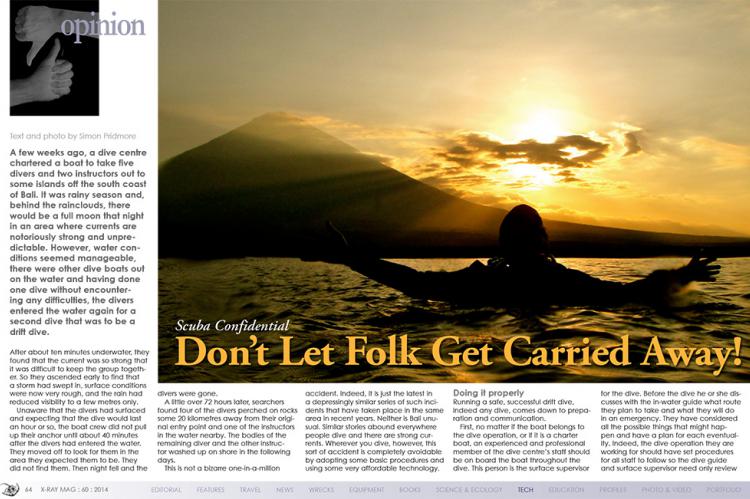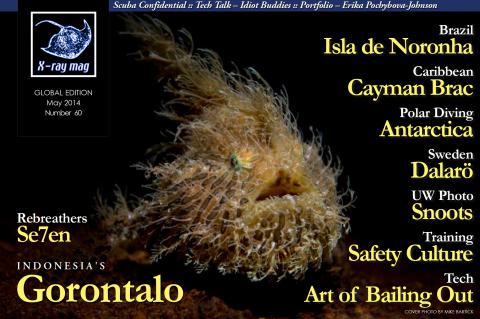Don’t Let Folk Get Carried Away!
A few weeks ago, a dive centre chartered a boat to take five divers and two instructors out to some islands off the south coast of Bali. It was rainy season and, behind the rainclouds, there would be a full moon that night in an area where currents are notoriously strong and unpredictable. However, water conditions seemed manageable, there were other dive boats out on the water and having done one dive without encountering any difficulties, the divers entered the water again for a second dive that was to be a drift dive.
Tags & Taxonomy
After about ten minutes underwater, they found that the current was so strong that it was difficult to keep the group together. So they ascended early to find that a storm had swept in, surface conditions were now very rough, and the rain had reduced visibility to a few metres only.
Unaware that the divers had surfaced and expecting that the dive would last an hour or so, the boat crew did not pull up their anchor until about 40 minutes after the divers had entered the water. They moved off to look for them in the area they expected them to be. They did not find them. Then night fell and the divers were gone.
A little over 72 hours later, searchers found four of the divers perched on rocks some 20 kilometres away from their original entry point and one of the instructors in the water nearby. The bodies of the remaining diver and the other instructor washed up on shore in the following days.
This is not a bizarre one-in-a-million accident. Indeed, it is just the latest in a depressingly similar series of such incidents that have taken place in the same area in recent years. Neither is Bali unusual. Similar stories abound everywhere people dive and there are strong currents. Wherever you dive, however, this sort of accident is completely avoidable by adopting some basic procedures and using some very affordable technology.
Doing it properly
Running a safe, successful drift dive, indeed any dive, comes down to preparation and communication.
First, no matter if the boat belongs to the dive operation, or if it is a charter boat, an experienced and professional member of the dive centre’s staff should be on board the boat throughout the dive. This person is the surface supervisor for the dive. Before the dive he or she discusses with the in-water guide what route they plan to take and what they will do in an emergency.
They have considered all the possible things that might happen and have a plan for each eventuality. Indeed, the dive operation they are working for should have set procedures for all staff to follow so the dive guide and surface supervisor need only review these and plan for any last minute issues that might have arisen, such as, during rainy season, the likelihood of a sudden rainstorm.
The sole function of surface supervisors is to monitor the dive. Their role is as crucial as that of the guide. They watch the bubbles initially to see if the guide is following the plan, and once the divers are en route, they instruct the boat crew to move and accompany the divers from a distance.
If difficult water or weather conditions arise, they ask the captain to bring the boat closer. They remain alert and ready to assist if there is a problem, for example if anyone makes an early ascent, and stay on watch until the whole dive team is safely back in the boat.
A little bit of kit
In scuba diving, we carry safety sausages and noisemakers to help a dive boat find us if we are lost at sea. These are essential pieces of equipment and everyone should have them on every dive. However, it is sadly futile to deploy a safety sausage or blow a whistle if nobody is there.
In the incident described above, the divers might have had safety sausages raised, but for at least the first 30 minutes that they drifted, nobody even knew that they had surfaced. Then when the boat did start looking, it is likely that the surface conditions had swept the divers away, and the boat was searching in the wrong place. Then it got dark and the divers were gone.
In remote backcountry skiing, where avalanches are a risk, everyone is equipped with an avalanche beacon, a device that constantly emits a signal. In the event the skier is buried, the signal helps a rescue team find them. Now, wonderful as it may be to imagine a world in which every diver is required to carry an emergency signalling beacon in the event that they become lost at sea, this is unlikely to happen any time soon.
However, there are simpler and more practical alternatives available right now. Last year, a Singapore technical diving instructor found himself drifting alone in the South China Sea after a series of unusual events. He looked around, saw where he was in relation to the land, pulled out his hand-held GPS radio that he carries on every dive in a dedicated pressure resistant box and called the boat to come and pick him up — no drama!
The cost of a radio like this is under US$300. So a US$600 investment pays for a unit for a dive guide and another for the surface supervisor. As long as the guide maintains contact with his team and the radios are well maintained, the risk of loss at sea becomes tiny.
Improving standards
With a little forethought regarding procedures, better staff assignment and a little cheap technology, the seven divers would not have been lost that day. It would not have taken three days to find them. They would not have needed the miracle chance that the sea carried them towards some rocks to survive and two would not have lost their lives.
Dive operators must look at the way they handle dives, especially in locations that are known diving black spots. Divers can play a role in improving standards, too, by asking the right questions and making sure that they dive with operators that are properly prepared and equipped. ■
Simon Pridmore has been around the scuba diving industry in Asia, Europe and the USA (well, Guam) for the past 20 years. His latest book, also called Scuba Confidential, was published in September and is available on Amazon.
Download the full article ⬇︎

Originally published
X-Ray Mag #60
Indonesia's Gorontalo; Cayman Brac; Antarctica; Brazil's Fernando de Noronha; New Dalarö wreck park in the works in Sweden; Reviewing Poseidon's SE7EN rebreather; The art of bailing out; Idiot buddies; Safety culture; Scuba Confidential; Sensational snoots; Overview of photo editing software; Seacam Academy; Florida's artificial reefs; Erika Pochybova-Johnson portfolio; Plus news and discoveries, equipment and training news, books and media, underwater photo and video equipment, shark tales, whale tales and much more...


